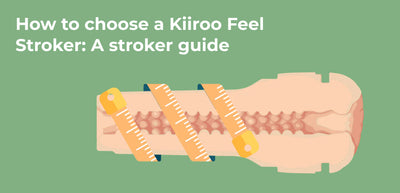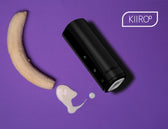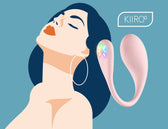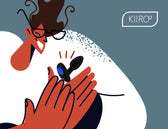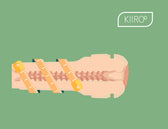Vaginismus: Why Sex Hurts (And How to Overcome It)
My heart is pounding, I take a deep breath and begin to slide it in. It’s absolutely agonizing. I cringe and persist, but it’s almost unbearable. It feels like I’m sliding a sharp knife into my body. The sting spreads and I try to calm myself with deep breaths, trying to acclimatize to the excruciating sensations. It doesn’t work. In the end, I decide enough is enough. Slowly, with great amounts of pain and a lot of tears, I remove the Q-Tip from my vagina
What is Vaginismus?
This is one of my most prominent memories from my own time as a vaginismus sufferer and, unfortunately, chances are that others have gone through similar experiences too.
Vaginismus is a medical condition in which the pubococcygeus muscles (otherwise known as the PC muscles) spasm involuntarily, making intercourse incredibly painful or near impossible. These involuntary spasms typically make medical examinations and inserting a tampon painful experience too, hindering the sufferer in even more ways.
The physical symptoms of Vaginismus can vary, but are generally considered to include a tightening sensation of the vagina, which hinders or prevents the vaginal penetration (some describe it as being like ‘hitting a wall’), a burning or stinging sensation when penetration is attempted, an intense fear of penetration brought on by the pain which causes avoidance of further sexual activities.
Some people who suffer from Vaginismus will still experience arousal and may even enjoy pleasuring themselves or have their partner(s) pleasure them, but generally, vaginal penetration is avoided in all instances due to the pain during sex it induces.
It’s hard to say exactly how many people suffer from Vaginismus due to the shame associated with it and the tendency in some cultures to ignore the implications of painful intercourse. However, on average, it is agreed that about 1-7% of people in the world may suffer from it at any given moment (though some studies estimate higher rates).
In general, there are two different types of Vaginismus—primary, in which the person felt pain for as long as they have tried penetrations, and secondary, in which pain-free penetration was once possible but now isn’t. Both of these cases can be very frustrating.
Why Do People Suffer From Vaginismus?
Vaginismus, although it has many physical symptoms, is generally seen as a psychological condition which is self-reinforcing.
Once pain is anticipated by the brain the vagina acts to protect itself by causing the PC muscles to spasm shut during attempts at penetration. This then causes the pain associated with Vaginismus, which goes on to cause a ‘Cycle of Pain’—in which the sufferer anticipates pain so their muscles clamp shut, meaning they experience pain and then anticipate more from the next encounter, meaning they clamp up and the cycle goes on.
Because of this, the cause of Vaginismus among sufferers is often rooted in some form of mental trauma which has caused them to associate sex with fear or pain.
For some, this can be a result of the natural pressures put on women by society and the scaremongering tactics that cultures take towards penetration. A strong religious upbringing or inaccurate sex education are prime suspects when it comes to primary vaginismus.
Sadly, some women with vaginismus have experienced violent forms of sexual dissuasion in their lifetime—such as a childhood trauma, abuse, or rape. In these cases, the brain responds to the fear caused in these situations by trying to protect the body further but only makes things worse for the person trying to find recovery and healing.
Vaginismus can also be triggered by physical causes, such as sex during a UTI, pain from childbirth, certain medications or medical conditions (such as vulvodynia) and even a lack of proper lubrication and foreplay. Once the pain has been experienced and the body anticipates fear the ‘Cycle of Pain’ can start coming into effect, resulting in Vaginismus.
How Is Vaginismus Treated?
When I was slowly pulling a cotton swab out of my aching vagina I would have never anticipated that one day I would go on to be a sex toy reviewer and general lover of all things dildo. But the good news is that there is light at the end of the ever-expanding vaginal canal and Vaginismus is treatable.
Because Vaginismus is so personalized going to a doctor to get an appropriate diagnosis and treatment method is a must. However, there are some common trends in treatment which can be observed.
Most doctors will recommend that you avoid trying partnered penetration until you have taken smaller steps to help make this manageable. Sex therapy is usually recommended to get to the root of the issue and to provide some cognitive behavioral tactics to help retrain the brain’s fear response to penetration.
Kegel exercises are often prescribed too, as being vaginal dilators. The dilators are a set of insertable devices which gradually increase in length and girth and the Vaginismus sufferer is encouraged to essentially train their way up to the largest size through a slow-and-steady approach. In all cases, a good, body-safe lubricant is a must and the support of your partner/s and friends and family (where appropriate) is a highly valued asset on the road to recovery.
Sometimes it’s a long road to recovery, with a lot of twists and turns, but that road has an almost 100% success rate. Be persistent, forgiving, and open and you’ll eventually find that your vagina opens up too.
Written by
Emmeline Peaches
Guest Blogger
